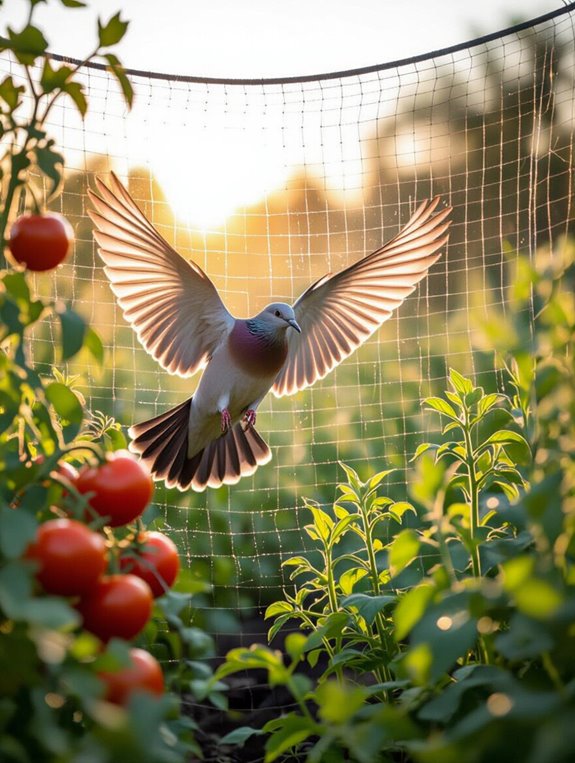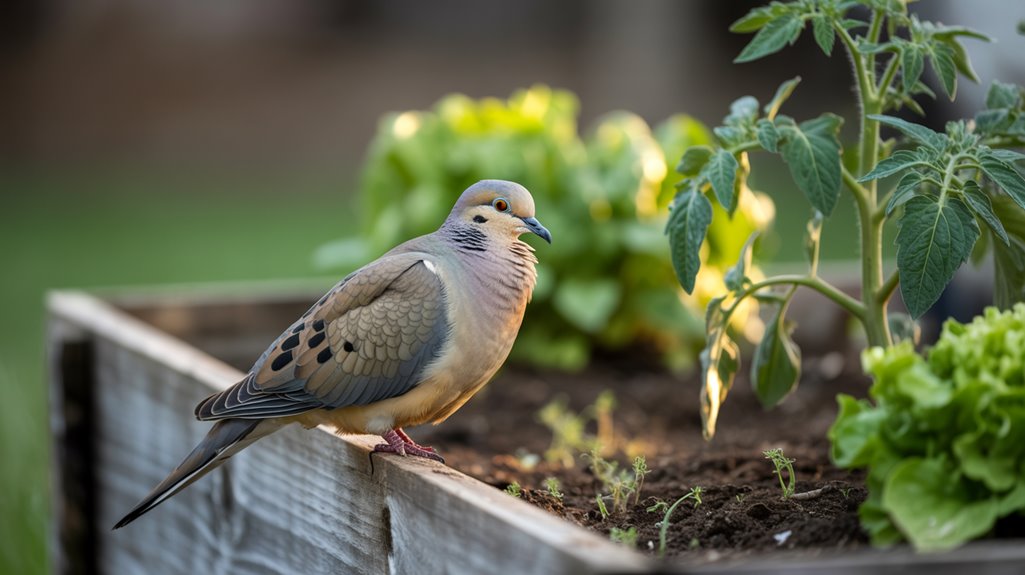You can protect your garden from mourning doves using three scientifically proven deterrent methods. First, exploit their natural fear responses by positioning reflective materials like aluminium foil or mirrors alongside predator decoys such as plastic owls near potential nesting sites.
Second, install physical barriers, including bird netting over crops and wire mesh around food sources, to block feeding access.
Third, eliminate attractants by removing bird feeders, clearing fallen seeds, and pruning dense vegetation where they prefer nesting. These exhaustive strategies offer lasting habitat modification results.
Key Takeaways
- Place reflective streamers, mirrors, or aluminium foil near nesting sites to create startling light patterns that exploit doves’ natural fear responses.
- Install bird netting over fruits and vegetables or use wire mesh barriers to prevent feeding access while maintaining garden aesthetics.
- Remove bird feeders, pet food containers, and water sources to eliminate attractants that draw mourning doves to your property.
- Deploy life-like predator decoys such as plastic owls or snakes near potential nesting areas to establish perceived threats.
- Prune dense shrubs and tree branches strategically while clearing fallen seeds and organic debris to reduce nesting opportunities.
Related post to read: Stop Mourning Doves in Your Garden.
1. Use Reflective Objects and Decoys to Scare Doves Away
Visual deterrents exploit mourning doves’ natural fear responses through the strategic placement of reflective materials and predator mimics. You’ll effectively keep birds away by positioning shiny streamers, mirrors, or aluminium foil near potential nesting sites. These reflective surfaces create startling light patterns that scare doves without harming them.
Deploy life-like predator decoys such as plastic owls or snakes to establish perceived threats around bird feeders and garden areas. Unlike restrictive bird netting, these methods allow beneficial species access while targeting problematic mourning doves specifically.
Combine reflective objects with predator decoys for thorough bird control. You must regularly relocate these deterrents to maintain effectiveness, as mourning doves adapt quickly to static installations.
This dynamic approach prevents habituation while preserving your garden’s natural ecosystem balance through humane behavioural modification techniques.
2. Install Physical Barriers to Block Access

When visual deterrents prove insufficient, physical barriers provide reliable exclusion through mechanical obstruction of dove access routes. Install bird netting from your local hardware store over fruits and vegetables to prevent feeding access.
Wire mesh creates impenetrable barriers around food sources while maintaining garden aesthetics. Bird spikes on perching surfaces eliminate roosting opportunities without harming doves. Suspend fishing line across open spaces to disrupt flight patterns effectively.
Cover shrubs and trees with netting to prevent nesting behaviours. Attach plastic sheeting to gazebos and pergolas for thorough protection.
These mechanical solutions work independently of environmental factors, unlike predator decoys or aluminium foil that require repositioning.
Physical barriers eliminate food and water access points while allowing you complete control over protected areas, ensuring long-term dove management success.

3. Remove Food Sources and Nesting Sites
Most effective dove control strategies target the fundamental resources that attract these persistent birds to residential areas.
You’ll need to systematically eliminate food sources and nesting opportunities to make sure your property becomes inhospitable to mourning doves.
Essential Resource Removal Steps:
- Eliminate feeding stations: Remove bird feeders, pet food containers, and water sources that birds will eat from regularly
- Prune vegetation strategically: Trim dense shrubs and tree branches where larger birds prefer nesting, creating an effective way to keep doves from establishing territories.
- Maintain debris-free zones: Clear fallen seeds, fruits, and organic matter that prevent birds from foraging successfully.
Keeping birds away requires consistent habitat modification. While a pie plate might temporarily scare birds, removing attractants provides lasting results.
This systematic approach helps keep mourning doves from viewing your garden as a suitable habitat without requiring physical barrier installation.
Final Thought
You’ve now learned three scientifically backed methodologies for humane mourning dove deterrence: visual deterrents utilising light refraction and predator mimicry, physical exclusion barriers that prevent access to target areas, and habitat modification through resource elimination.
When you implement these integrated pest management strategies consistently, you’ll achieve effective population displacement without causing harm to Zenaida macroura.
Remember that you’re modifying behavioural patterns through environmental manipulation rather than direct intervention, ensuring both efficacy and ethical wildlife management practices.
